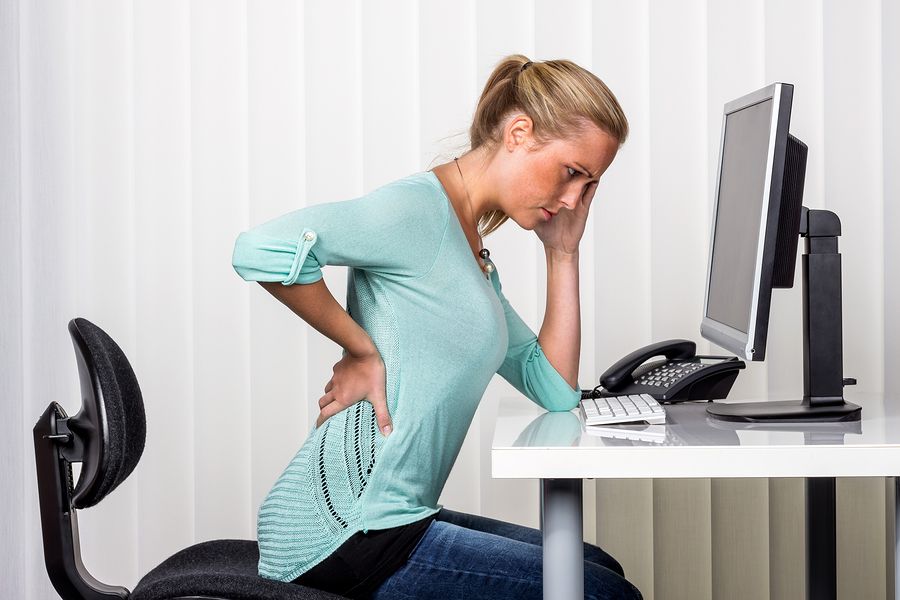So now that your neck pain has been addressed, what about your upper back?
Are these two regions of pain interrelated?
In simple, yes, they can be. Due to the close proximity of the neck to the shoulders and upper back, pain can often be experienced within these two regions at the same time.
The phrase “upper back” refers to the thoracic spine. The thoracic spine is the second spinal segment which stems from the base of the neck to the bottom of your ribcage.
To put your mind at ease, this is a common presentation, with 1 in 6 people experiencing reported back problems (Australian Institute of Health and Welfare).
What causes this interrelated pain?
As you can imagine, there are an abundance of causes of upper back and associated neck pain, however this blog is going to explore the three most common causes seen in private practice. These include:
- Poor posture
- Muscle tightness or strain
- Radiculopathy
1. Poor Posture
A poor posture whilst in a seated or standing position may place a severe load through the body’s neck and upper back muscles and joints, resulting in feelings of pain and discomfort.
These unnatural positions may prompt the body to go into what I like to call “fight mode”.
Why “fight mode”, and more importantly, what does that even mean?
Well it’s simple.
The joints and surrounding muscles of the neck and upper back increase in stiffness and tightness (or go into a muscle spasm) in an attempt to reduce the stress and load passed through this bodily region in order to protect it.
2. Muscle tightness or strain
3. Radiculopathy
Our neck is comprised of multiple spinal levels, from each of which a spinal nerve originates.
In patients with upper back radiculopathy, a neck spinal nerve is being pinched, compressed and irritated, resulting in either a tingling, numbness or sharp radiating sensation.
The region in the upper back where the individual is experiencing the pain provides insight into the spinal level and specific nerve being aggravated; most commonly due to joint stiffness.
What can you do to alleviate this pain?
For those of you who read Part 1 of this blog sequence titled “The bible to managing acute neck pain”, it may come of a surprise, however the means of management for upper back pain in isolation or with accompanying neck pain is very similar to the techniques suggested for wry neck/acute neck pain.
Medication – Non-steroidal anti-inflammatory drugs (NSAIDs) and pain management
Pain analgesia (medication) and non-steroidal anti-inflammatory drugs (NSAIDs) such as Ibuprofen or Voltaren may help reduce inflammation and pain within your upper back and neck within the first 48-72 hours.
These products can be purchased over the counter at your local pharmacy. Please be sure to consult the pharmacist or your local GP prior to ensure appropriate and safe use.
Reduce your muscle tightness
As aforementioned, commonly associated with upper back pain and spinal stiffness is muscle tightness. Means of reducing this tightness include:
The application of heat
This may be in the form of a hot water bottle/heat pack wrapped in a towel, or the application of topical massage creams such as Fisiocrem (all natural) and Deep Heat.
Gently rub in and apply the creams to the area of pain, tightness and discomfort.
Stretching!
Performing a pre-workout warm up and a post-workout cool down.
Stay hydrated!
I know the clinical recommendation of ensuring 2 litres of water intake sounds like a lot, however there really is benefit of doing so. Therefore, do yourselves a favour and buy a water-bottle to not only join the “health and fitspo” club, but more importantly to increase your body’s water retention and muscle hydration.
Consume magnesium supplements
Magnesium is a mineral that helps regulate muscle contractions, assisting muscles to relax.
Magnesium may be purchased from your local health food store in a powder or table form. Please liaise with a qualified working professional to determine the correct individualised quantity intake.
Stop activities that will aggravate your pain
Before you have seen your Physiotherapist, stop high neck and upper back loading activities such as heavy lifting, weight lifting, bike riding and the use of upper limb weights at the gym to name a few.
Adjust your posture – Mum: “Stand or sit up straight!”
As aforementioned, one of the common three causes of upper back with associated neck pain is due to postural habits.
Do you slouch too far forward? Is your upper back hunched?
Is your doppelganger the hulk? Do you lean too far backwards?
If you have answered yes to the above questions, I guess your mum was actually right in telling you to stand or sit up straight.
The way in which we stand or sit can be indicative of multiple muscle weaknesses, muscle tightness’s or our workplaces ergonomics.
Additionally, it can also lead to subsequent injury, as during this period of sustaining an unideal or “awkward” posture, we are increasing stresses and loads through isolated bodily regions. It is therefore important during the interim to make a conscious effort to actually do as your mum said and sit or stand up straight.
Implement strategies to assist you to do so, such as using a laptop stand when sitting or alternating to a standing desk.
Stretch!
It is important to remember it is good to keep your upper back and neck moving within a pain free range. I recommended above engaging in a pre-and post-workout stretching session. Stretching can improve blood circulation, increasing blood flow to your muscles.
Blood flow promotes cell renewal, which assists in speeding up the body’s healing processes. Therefore, it can improve your flexibility and reduce your muscle tightness asap!
Some easy to do stretches for your upper back and neck pain include –
Cat/cow, book openers and thoracic rotation and extension.
Watch the video below for visual demonstration of the above listed exercises.
Visit a Physiotherapist ASAP!
Upper back pain with or without the presence of associated neck pain responds remarkably to Physiotherapy treatment.
Your Physiotherapist will first thoroughly assess you to better understand your presenting pain and reduced function.
Following this assessment, a range of treatment methods may be used such as:
- Taping, specifically for postural correction
- Soft tissue massage
- Gentle mobilisations
- Ultrasound machine – The application of heat and stimulation to promote cell healing.
- Education – Surrounding the “do’s and don’ts” as listed above under “What can you do to alleviate this pain?”.
- Specific individualised home exercise program including both stretches and strengthening exercises. These exercises aim to increase the upper back, shoulder and neck range of motion, improve muscle endurance, improve muscle stabilisation and improve muscle strength to reduce your pain, prevent a recurrence or further injury.
As you progress through your Physiotherapy sessions (quantity as recommended by your Physiotherapist) and your presenting pain begins to reduce and subside, other appropriate interventions may be utilised such as:
- Deep tissue massage
- Dry needling
An intervention that aims to reduce pain by releasing deep tissue and muscle tightness. Instead of leaving the needle stationary (as done in acupuncture), the qualified Physiotherapist will “flick” and “twitch” the needle as to stimulate muscle contraction release.
- Increased mobilisation strength and pressure
Specific individualised home exercise program progression including both stretches and strengthening exercises.
- Recommendations regarding your gradual return to activity and sport.
Clinical group Physiotherapy exercise/Pilates classes
Once your upper back and associated neck pain has been successfully managed and you are no longer experiencing debilitating pain, joining clinical pilates classes conducted by a Physiotherapist is highly recommended.
Pilates is an amazing clinically proven means of exercise that will allow for the strengthening of your thoracic and cervical spine stabilisers, shoulder muscles and deep neck muscles.
It will assist in ensuring the ongoing maintenance of your pain free upper back and neck and reduce your risk of a future relapse!
If you are suffering from neck or upper back pain, or merely want to improve your posture, book an appointment with one of our qualified physiotherapists at Physio AUS at our Highett clinic on 1300 392 552 or book online now!
Please do not hesitate to call us if you have any questions.
Written by Jaime Bild – Physiotherapist

 1300 392 552
1300 392 552

Leave A Comment